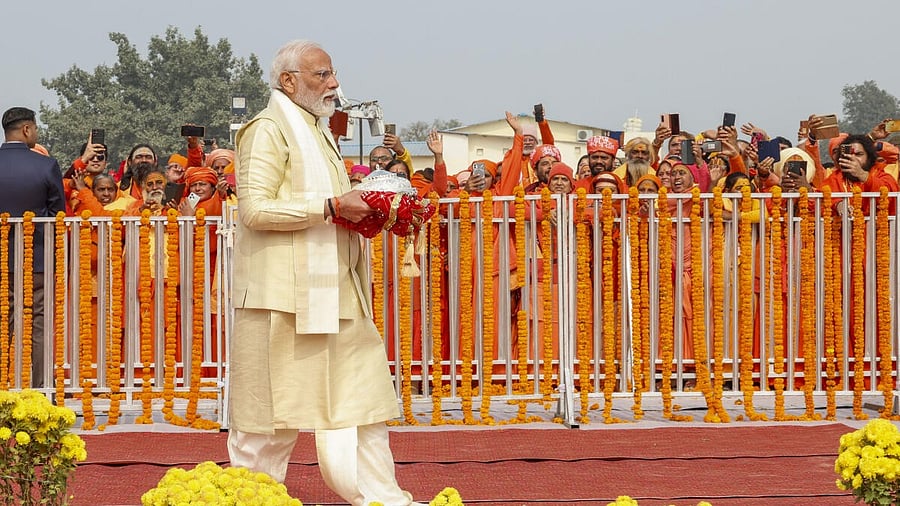
Prime Minister Narendra Modi arrives at the Ram Mandir for the 'Pran Pratishtha' ceremony, in Ayodhya, Monday, Jan. 22, 2024.
Credit: PTI Photo
In the fabric of a robust democracy, the distinction between a political party and the government is not just fundamental but sacrosanct. This boundary is crucial for preserving the principles of impartial governance and ensuring that state machinery operates without partisan interests. The recent inauguration of the Ram Mandir in Ayodhya, which saw the involvement of high-ranking officials of the state and the BJP, along with the deployment of state machinery, brings this delicate balance into sharp focus. At the heart of this discussion lies the question of how a democratic government, elected on the basis of a party’s manifesto, should navigate the implementation of its electoral promises, especially when they intersect with specific religious and cultural sentiments.
The BJP’s commitment to construct the Ram Mandir, a cornerstone of their electoral manifesto since the 1990s, symbolises a promise fulfilled. However, the extent of the government’s involvement in the temple’s inauguration ceremonies warrants scrutiny through the lens of democratic principles and constitutional propriety. This scenario illuminates the subtle yet significant encroachment of party agendas into the realm of state functions.
In 2019, the Supreme Court’s Ayodhya ruling identified two principal roles for the Union government: to allot the land and to make necessary provisions regarding the functioning of the now-called ‘Sri Ram Janma Bhumi Trust.’ Legally, the government’s role ended when the trust was formed, and provisions for its management were made. Executing the court-endowed responsibilities would suffice
to be seen as the current government’s fulfilment of the agenda made in its election manifesto. However, the current government has stepped far beyond the legal mandate and masked several party-related responsibilities as State action, blurring the line between party and government.
Drawing a clear separation between the party and the government is critical to maintaining constitutional ethos and propriety. It distinguishes us as a mature democracy, where State institutions display impeccable integrity. The deployment of State resources for party use is evident in the closure of the stock market and other institutions like AIIMS, NLCT, banks, courts, meat-selling shops, liquor shops, government-run hospitals, and state-run schools for party-related inaugurations on January 22. When the functions of the party overlap with the responsibilities of the State, the electorate is likely to believe that the organisational interests of the party and State institutions are synonymous. In a democratic state, the party is not a bureaucratic arm of the State nor is the State a tool of the party.
Since the BJP’s rise to power in 2014, India has witnessed a distinctive shift in the way the State embodies and enforces certain ideologies. Under Modi’s first term, beliefs of the BJP as a party have increasingly manifested as actions of the State. The ideological agenda of the Sangh Parivar, particularly Hindu nationalism, has permeated state actions more overtly. This period has been marked by state-level endorsement and implementation of policies that align closely with the party’s ethos, such as cow protection, the hijab ban, the erasure of Mughal history, and active opposition to inter-faith marriages. These elements, once the rallying cries of the party’s base, have transitioned into the broader State narrative, intertwining party ideology with State governance. This conflation signals a significant shift in the democratic landscape of India.
The key conflicting constitutional principle throughout the BJP’s tenure has been secularism. Often, people mistake that secularism invisibilizes religion. But this does not hold true for Indian secularism. India has, since Nehru’s post-colonial period, refused to privilege any one religion above all others while explicitly recognising that religion exists. The euphoria around Ayodhya shows an express shift in the long-held position on secularism in India and projects the present dispensation as the government of the majority.
Balancing a party’s agenda with democratic governance principles is a nuanced task. The key lies in ensuring that while a party’s agenda can bring necessary change and reform, it must be executed within the framework of democratic norms, respecting the rights and voices of all constituents, not just the majority. A political party prior to its victory in an election is a private actor that frames its agenda based on the highest chance of winning, and when voted to power, this agenda must be tested on constitutional procedure and broader democratic principles. The political parties are transient, while the State is perpetual. When their differences cease, our democratic values fade and expectations of the sole non-partisan arm, the judiciary, escalate.
The Ayodhya case serves as a stark reminder of the treacherous path when party lines bleed deep into the State. It’s not just about a temple; it’s about upholding the delicate balance between faith, politics, and constitutional principles. For the longevity of our democracy, India must strive for institutional independence.
(Adithi Holla is a legal
researcher, and Atreya is a
management consultant in the US and an advocate in
Karnataka HC)